Monthly ArchiveApril 2006
Daily post 13 Apr 2006 07:11 am
Screenings A’ Comin’
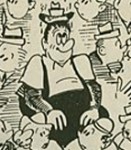 – The ASIFA Hollywood Animation Archive has posted a fabulous book of cartoons by Milt Gross. This was given them by Kent Butterworth. (Thank you, Kent.)
– The ASIFA Hollywood Animation Archive has posted a fabulous book of cartoons by Milt Gross. This was given them by Kent Butterworth. (Thank you, Kent.)
Take a look at this material; Milt Gross was just one great cartoonist in the ’30′s. Everything he did was funny, and his short work with Warner’s & MGM produced some good moments. It’s all connected, isn’t it?
Kudos to the Animation Archive; their work is necessary and it’s always a pleasure to check in to their web site. I would love to see some animation art posted there, but I’m happy to take what they give me.
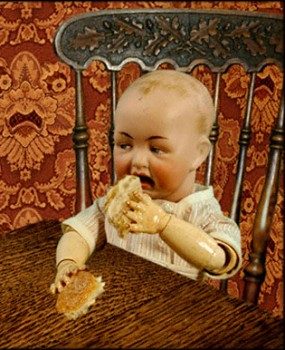 - The Tribeca Film Festival is rearing its lively head, and we’ve had some last-minute round-the-clock revisions to our short playing there. The music is being cut in today (hopefully it’ll match). The schedule should feel tense, but somehow it doesn’t. We have to get it in to the Fest’s hands tomorrow. Talk about cutting it close; that’s when our DigiBETA should exit the dubbing studio. Just a messenger away.
- The Tribeca Film Festival is rearing its lively head, and we’ve had some last-minute round-the-clock revisions to our short playing there. The music is being cut in today (hopefully it’ll match). The schedule should feel tense, but somehow it doesn’t. We have to get it in to the Fest’s hands tomorrow. Talk about cutting it close; that’s when our DigiBETA should exit the dubbing studio. Just a messenger away.
- For some truly Independent animated films debuting in NYC, the Film Forum is screening a great group of films May 10-23:
The titles and film makers include:
The Flooded Playground by Lisa Crafts (20 mins.) (Pictured to the right.)
It Pains Me to Say This by George Griffin (10 mins.)
The Back Brace by Andy London & Carolyn London (6 mins.)
El Doctor by Suzan Pitt (23 mins.)
Who I Am and What I Want by Chris Shepherd & David Shrigley (7½ mins.) British
Everybody’s Pregnant by Debra Solomon (5 mins.)
Dog by Suzie Templeton (5½ mins.) British
Son of Satan by JJ Villard (10 mins.)
As we get closer to the screening date, I’ll post this again. Included is an opening night screening with film makers Q&A. I’m looking forward to it, and want to make sure I post a reminder. In the meantime, mark it in your calendars.
- More current: Next Wednesday, April 19th at the Jacob Burns Film Center there will be a showing of 3D and puppet animated films. The films, for the most part, are on the dark side and show a good cross section of various styles of object animation.
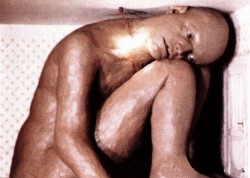 They’ve put together a dense program. The films include:
They’ve put together a dense program. The films include:
THE PAINTED PRINCESS – Pooh Kaye. 1994. US.
THE GREAT COGNITO – Will Vinton. 1982. US.
PONY GLASS – Lewis Klahr. 1997. US.
CRACKING CONTRAPTIONS – Nick Park. 2002. UK.
STREET OF CROCODILES – Brothers Quay. 1986. US.
MORE – Mark Osborne. 1998. US.
(and pictured above) DARKNESS/LIGHT/DARKNESS – Jan Svankmajer. 1989. Czech
Showings are ar 6:00pm and 7:50. The Jacob Burns Film Center, at 364 Manville Road in Pleasantville, NY. For Directions.
Animation Artifacts 12 Apr 2006 07:31 am
Kimball
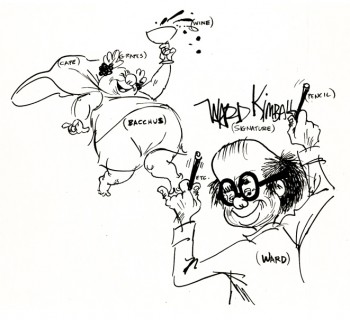 – For no good reason, I thought I’d post these beautiful drawings by Ward Kimball. I have a bunch more and will post those eventually. I’m not sure how many made it into books since I’ve had these photostats for so long that they’re very familiar to me.
– For no good reason, I thought I’d post these beautiful drawings by Ward Kimball. I have a bunch more and will post those eventually. I’m not sure how many made it into books since I’ve had these photostats for so long that they’re very familiar to me.
It’s great to see this quality of draftsmanship in animation; Kimball had an original style on top of his amazing ability to draw. This, of course, doesn’t even mention the fact that he was a brilliant animator with a unique animation style.
(Click on images to enlarge.)
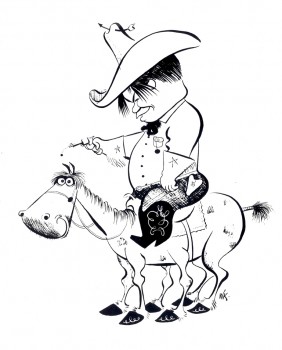 Now, no one needs me to give my thoughts on Kimball’s work, but I think it is valuable to be reminded of his brilliance.
Now, no one needs me to give my thoughts on Kimball’s work, but I think it is valuable to be reminded of his brilliance.
If we only had the crow dance in Dumbo, or Jiminy Cricket in Pinocchio we would have had to classify him as a master. Take a look the Mad Hatter in Alice in Wonderland or his direction on Toot Whistle Plunk and Boom, and you have proof positive. His Tomorrowland episodes for the Disneyland TV show (“Man in Space,” “Man and the Moon”, “Mars and Beyond” or “Our Friend the Atom”) were intelligent attempts to explain science of the day.
There are some pieces he did that I out and out don’t like (Bacchus in Fantasia or It’s Tough To Be A Bird), but I’ll say that those are just not my taste – too overdone, too broad, too cute. However, Kimball was something of a genius who stood out from the others at Disney. Just l0oking at his drawings make you smile; they’re so smooth.
Note: Thanks and regards to John Canemaker who reminded me that he gave me these drawings/photostats. The first appears in his Nine Old Men book and is just a small part of what makes that book such a gem.
Art Art 11 Apr 2006 07:38 am
Motley
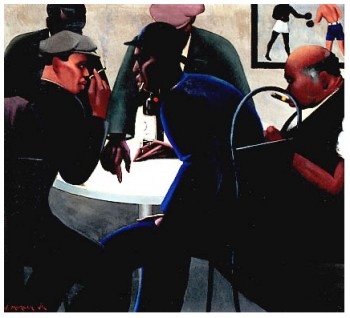 - An artist whose work has really grabbed me this past year is Archibald Motley Jr.. He was born in New Orleans in 1891 and died in 1981. His parents moved him to Chicago with them when he was one year old. His father was a Pullman porter on the Michigan Central Railroad; this is where he met Dr. Frank W. Gunsaulus, President of what was to become the Illinois Institute of Technology. Gunsaulus took an interest in young Archibald and ultimately helped him get into the art institute of Chicago. He worked with his father for a while on the railroad, but continued to draw, paint and exhibit. After winning a grant in 1929, he studied in Paris for a year before returning to his home, Chicago, where he worked most of his life.
- An artist whose work has really grabbed me this past year is Archibald Motley Jr.. He was born in New Orleans in 1891 and died in 1981. His parents moved him to Chicago with them when he was one year old. His father was a Pullman porter on the Michigan Central Railroad; this is where he met Dr. Frank W. Gunsaulus, President of what was to become the Illinois Institute of Technology. Gunsaulus took an interest in young Archibald and ultimately helped him get into the art institute of Chicago. He worked with his father for a while on the railroad, but continued to draw, paint and exhibit. After winning a grant in 1929, he studied in Paris for a year before returning to his home, Chicago, where he worked most of his life.
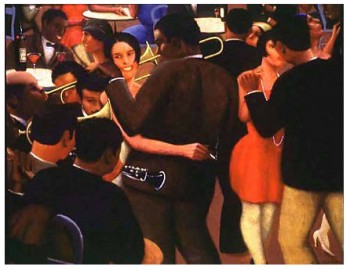 His work has been associated with the Harlem Renaissance, though he never lived in Harlem. He painted portraits and the world he was close to, always very personal work. His portraits focus on the character of his subjects and are very direct in approach. Many of these portraits present strong women performing ordinary tasks. Though, his most famous paintings record the cafe settings in Chicago during the height of the Jazz era.
His work has been associated with the Harlem Renaissance, though he never lived in Harlem. He painted portraits and the world he was close to, always very personal work. His portraits focus on the character of his subjects and are very direct in approach. Many of these portraits present strong women performing ordinary tasks. Though, his most famous paintings record the cafe settings in Chicago during the height of the Jazz era.
To me, his work vibrates with life, merging the styles of early Joseph Stella and Thomas Hart Benton. Motley’s ethnicity vibrates to the core of his work. Sensitive colors, a dynamic line, crowded groupings of people all teeming with life.
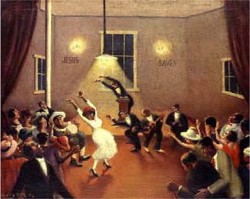 His use of black is bold and striking, framing bits and pieces of characters so that he can create a mood. This helps to highlight colors he sparkles around the painting. There’s a music playing in his head, and we can almost hear it in these paintings.
His use of black is bold and striking, framing bits and pieces of characters so that he can create a mood. This helps to highlight colors he sparkles around the painting. There’s a music playing in his head, and we can almost hear it in these paintings.
Fortunately we have an oral history of his life recorded in the Library of Congress to preserve some of his thoughts. There’s one relatively recent book available, Archibald J. Motley Jr. by Amy Mooney.
(Click on any image to enlarge.)
Featured paintings:
1. The Plotters (1933)
2. Blues (1929)
3. Tongues (1927)
Animation &Commentary 10 Apr 2006 08:45 am
Talking heads
- Yesterday I visited my mother and met up with one of my brothers there. During the ball game a Chas Schwab commercial came on. Perhaps you know the one: Bob Sabiston did it . That rotoscope animation of a man eating and talking to the camera about investments.
My brother said, during the spot, that the commercial is creepy. My mother said the same; she didn’t like looking at it and couldn’t understand why they didn’t just show the film of the guy eating, why did they have to animate it. I listened amused.
It was just yesterday that I was defending this style of work with Richard Linklater‘s upcoming film, A Scanner Darkly. Of course, there’s a difference – at least to me – between a Bob Sabiston commercial and a Richard Linklater film. Isn’t this the same territory?
I told my family that it had to be animated so that they would notice it. If it had just been a film of the guy eating talking to the camera, they wouldn’t be talking about it now . . . they wouldn’t have even noticed it. (Though I had to admit that it took a half dozen viewings before I realized who it was for, and I consciously looked for that.) It’s funny in that my 30 secs. or research on this spot led me to a site for a guy who rants about things. Sure enough, he has a page devoted to this series of commercials, and I think it’s obvious that a lot of people are bothered by this style. There’s also a good Slate article about it. (They offer two of the spots to view and an NPR conversation to listen to.)
Now the reason I’m so interested in all this is a short film I have in mind. It’s going to cover the same boring territory as this commercial, but with a more animated person. I’m curious to see where it takes me, just as I wonder where it might have taken Richard Linklater if he had actually animated his films (in 2D, of course) .
Animation 09 Apr 2006 08:17 am
Boy’s Life
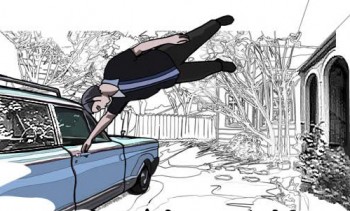 - When I posted links to some articles about Richard Linklater‘s upcoming film, A Scanner Darkly, I expected a number of animators to attack Linklater’s earlier film, Waking Life. I can remember few other animators I discussed it with who liked it. However, the one comment by Daniel Thomas was totally unexpected: “For all the childish snobbery against Linklater’s independent movie using computers to paint over video footage, I really can’t think of anyone else who’s even bothered to try to create a serious animation film in this country. In America, “animation†means “babysitter,†and “adult animation†really means “S&M for teenage boys.†American animation, for whatever reasons I really need to explore, is stuck in some sort of time-warp. It’s as if the art world became so enamored by Monet’s water lillies that they refused to even consider anything else.”
- When I posted links to some articles about Richard Linklater‘s upcoming film, A Scanner Darkly, I expected a number of animators to attack Linklater’s earlier film, Waking Life. I can remember few other animators I discussed it with who liked it. However, the one comment by Daniel Thomas was totally unexpected: “For all the childish snobbery against Linklater’s independent movie using computers to paint over video footage, I really can’t think of anyone else who’s even bothered to try to create a serious animation film in this country. In America, “animation†means “babysitter,†and “adult animation†really means “S&M for teenage boys.†American animation, for whatever reasons I really need to explore, is stuck in some sort of time-warp. It’s as if the art world became so enamored by Monet’s water lillies that they refused to even consider anything else.”
There’s enough meat in that paragraph to write endlessly. Linklater’s talky style of film making isn’t for every taste; he’s the closest we have to Eric Roehmer in this country. (Before Sunset was, to me one of the finest films of the past ten years.) Waking Life was a variation on Slackers with more of a story: an animated The Pilgrims Progress. It’s dismissed completely by the animators and artists within the Industry.
The least one could say is that the director tried something different with animation. In the seventies, I probably would have been upset at his use of the rotoscope, but now the medium has gone a step closer to live action – with motion capture. (That’s a breed of film making that I wouldn’t even call animation.)
If Linklater had worked with graphic artists and told his story 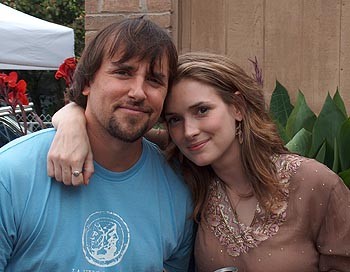 in a more conventional version of animation, would animators have supported it? I still don’t think so, but they wouldn’t have been able to complain about the process. I don’t remember too many complaints about Sin City‘s techniques; that one didn’t even use rotoscope to get similar effects in telling their story. However, in its dull way, it was a more conventional “boy’s” film – yet, another “graphic novel” on film. Two more of those are finished.
in a more conventional version of animation, would animators have supported it? I still don’t think so, but they wouldn’t have been able to complain about the process. I don’t remember too many complaints about Sin City‘s techniques; that one didn’t even use rotoscope to get similar effects in telling their story. However, in its dull way, it was a more conventional “boy’s” film – yet, another “graphic novel” on film. Two more of those are finished.
(Richard Linklater & Winona Ryder shooting A Scanner Darkly.)
Changes seem to be in the wind. I look forward to A Scanner Darkly – not for its animation techniques, but for Linklater’s version of the Philip K. Dick story. Perhaps it’ll be more a boy’s film and more popular. Certainly, he’ll have something to say.
- Daniel Thomas, by the way, has two good weblogs worth visiting. Conversations on Ghibli – a thorough exploration of Miyazaki and the Ghibli oeuvre – and Daniel Thomas.org – “an arts and entertainment webzine” that I found very entertaining.
Animation &Hubley &Richard Williams 08 Apr 2006 08:33 am
Rambling Rambling
To put it in a nutshell:
Back in the early ’60′s animation busted out of the studios. The Hubley surprise Tender Game of 1958 was followed by Moonbird in 1959. Suddenly people realized full well that they could use this medium to do more than make people laugh – and they could do it Independently and out of schools and on a shoestring. Annecy and Zagreb showed up to show the films, and a new world was born from the remains of UPA.
Dick Williams did The Little Island. George Dunning did The Flying Man. Borowczyk and Lenica did Dom. Fred Wolf did The Top. Bruno Bozzetto did The Two Castles. The Zagreb studios grew wildly and quickly and made exciting films.
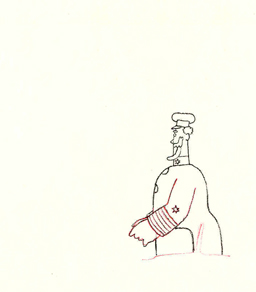 – The first feature to capitalize on this 60′s renaissance of animation (excluding Hubley’s own feature Of Stars and Men) and rehash what had been done by the Independent crowd, was The Yellow Submarine.
– The first feature to capitalize on this 60′s renaissance of animation (excluding Hubley’s own feature Of Stars and Men) and rehash what had been done by the Independent crowd, was The Yellow Submarine.
The Beatles sponsored something just this side of daring. However, those of us in the know were aware that it had already been done in shorts. We’d seen it in festivals. We’d seen it at ASIFA. The modest success of that feature made it more mainstream, and it wasn’t long before Beavis and Butthead came along.
- I remember the streets of New York lined with cels from The Yellow Submarine. Every Manhattan stationery sold them. Marketing. Those cels stayed in store windows for years, it seemed. (click on image to enlarge.) For the most part, they were selling for $75.
I remember not thinking they were worth it.
Today, of course, they sell for $1000 and up, but then it’s probably the same difference given the value of money today.
- I’m glad to see that Bruno Bozzetto will have a retrospective in Ottawa. It was in Ottawa in 1978 that his feature Allegro Non Troppo was a surprise midnight screening. An instant hit with that crowd. No advance publicity had us all walking on heaven when that film ended. I can still remember the bubbling enthusiasm when we left the theater at 1:30am. It was an animator’s delight. It’ll be nice to see the return to Ottawa.
(New Yorkers will have a special ASIFA East meeting to honor Bozzetto and see his films just prior to Ottawa in September.)
SpornFilms 07 Apr 2006 07:50 am
Airing It Out
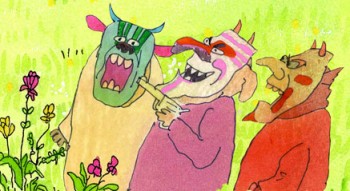 – Coming soon to a theater near you . . .
– Coming soon to a theater near you . . .
I mean, The Amazing Bone will be screened at the Museum of Modern Art on Saturday, April 15th at noon. It’s part of the Family Film programs run by the museum. I’m glad to be playing on the same program with Steve Segal’s film, Russian Rooster.
- To continue the self promotion . . . the new season of Between The Lions begins this month on PBS. We have three book adapted films in the series. Check your local listings for times.
Airing on April 17th is Knuffle Bunny. An adaptation of Mo Willems’ Caldecott Honor book.
On April 24th, is Sheep On A Ship. It’s adapted From The Book By – Nancy Shaw and Margot Apple
Finally, on May 8th Jamaica Louise James will air. It’d adapted From The Book By – Amy Hest and Sheila White Samton.
All three pieces, in one way or another, have these talented folk involved in the production:
Directed by – Michael Sporn
Animated by – Michael Sporn, Matt Clinton, Diego Turcios
Production Coordinated by – Adrian Urquidez
Edited by – Paul Carrillo
Rendered by – Adrian Urquidez, Matt Clinton, Diego Turcios, Clio Calman, Rachel Coleman
These were fun to animate, and I think they work well within the shows. (I just got final copies from the producers, and I must say the program looks great.)
SpornFilms 06 Apr 2006 07:21 am
Champ
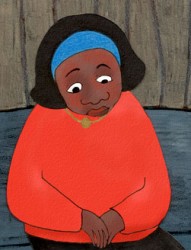 – Our heart goes out to Champagne Saltes Robinson whose mother, Genevieve, passed away Monday afternoon of a heart attack.
– Our heart goes out to Champagne Saltes Robinson whose mother, Genevieve, passed away Monday afternoon of a heart attack.
Champagne, of course, was the featured character in my film, Champagne. It was her life story – up to age 14 – that we tried to document in animation back in 1997. Champagne was raised in a convent while her mother was imprisoned. She also worked in our studio for a short while as a runner. (She got to do a bit of coloring on the film about herself.)
Champagne has just moved back to New York from Denver with her husband and one year old son, Jaysin. I’m sure it’s a sad return, but we wish her the best.
~
- John Celestri’s comments on my Double Lives page prompted a lot of thought.
Michael Barrier on his site talks about the one film/one character model as perfect for animation. This made me think about the animator that is asked to do more than one character on a film – and possibly sharing all of them with other animators. But for the sake of argument, let’s say that one animator is the only one to do those several characters.
Now let’s talk a little about my world – the one of Independent, short films. In shorts, there are two kinds of films – those with budgets and those without. Even within those two groups there’s play.
The early Disney films tried to break things up by character – there was the Goof specialist, the Mick specialist, the Duck specialist. Warner Brothers had the supervising director who dominated. This certainly had a lot to do with the way the studio was set up and the budgets. Only with a dominant director like Clampett or Jones and animators, who fell well within their way of thinking, would a rich style jump out.
Rooty Toot Toot followed the strong director mold, but it also broke the film up into characters. Masters like Grim Natwick and Art Babbitt took charge of principals – each telling their side of the courtroom drama. Hubley did a variant of that when he went solo. He knew what Bill Littlejohn, Tissa David, Barrie Nelson or Phil Duncan would give him, and he cast them accordingly.
But then the Independent world of today has the director as animator. Bill Plympton not only draws all of his characters but does the backgrounds as well. George Griffin and John Canemaker do the same in their short films.
There are many variants of the model caused by circumstances outside of the film that mold how that film will be done. Even knowing that the best way may be one animator/one character, the Independent film maker still has to try to make it work the best way possible for all those circumstance and still bring a soul to the short.
In the film mentioned above, Champagne, I was pretty much all that I could afford. For a good part of the film, purposefully, I worked without a storyboard. I improvised the scenes as I went (knowing full well what would come next – in my head).
In the middle of the film, when Champagne’s life started to settle down, I brought in someone I worked with frequently, Jason McDonald, to storyboard the last half of the film. He brought a completely different direction to it, and it allowed me to open up and improvise on his methods. I bought myself – and the Champagne character in the film – a security blanket to fall back on. I’d bet no one watching the film can tell where Jason’s work started, but I think the outside alteration gave more depth to the animation I was doing. A change for me and the character.
Animation &Daily post &Miyazaki 05 Apr 2006 06:48 am
Turner Cartoon Movies
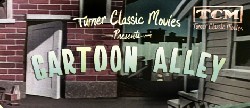 - This is a short reminder that Turner Classic Movies airs some older animated shorts with excellent prints on Saturday mornings at 11:30am. (Naughty But Mice is Chuck Jones’ first short starring Sniffles.)
- This is a short reminder that Turner Classic Movies airs some older animated shorts with excellent prints on Saturday mornings at 11:30am. (Naughty But Mice is Chuck Jones’ first short starring Sniffles.)
The schedule for April is as follows:
April 8 11:30 AM Cartoon Alley #13
Features three Sniffles the Mouse cartoons: Naughty But Mice (1939), Little Brother Rat (1939) and Sniffles and the Bookworm (1939).
April 15 11:30am Cartoon Alley #14
Features three Droopy Dog cartoons: Dumb Hounded (1943), Shooting of Dan McGoo (1945) and Wild and Woolfy (1945).
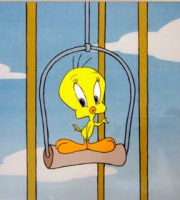 April 22 11:30am Cartoon Alley #15
April 22 11:30am Cartoon Alley #15
Features three Tweety Bird cartoons: A Tale of Two Kitties (1942), Birdy and the Beast (1944) and A Gruesome Twosome (1945).
Apil 29 11:30am Cartoon Alley #16
Features three MGM Cinemascope Cartoons: Millionaire Droopy (1956), The Cat’s Meow (1957), Tops With Pops (1957).
- For those desperate for their monthly Miyazaki hit, May will offer a rerun of the Miyazaki films in the late night schedule on TCM (with dubbed English versions). The schedule is as follows:
May 5 – 2:00am Castle in the Sky (1986)
A boy and girl race pirates to find a legendary floating castle.
Cast: Voices of James Van Der Beek, Anna Paquin, Mark Hamill. Dir: Hayao Miyazaki
4:15am Porco Rosso (1992)
An airplane pilot with a pig’s head devotes his life to rescuing others.
Cast: Voices of Michael Keaton, Cary Elwes, Kimberly Williams. Dir: Hayao Miyazaki
May 12 - 2:00am Princess Mononoke (1999)
A woman raised by wolves leads forest animals in a fight to save their homes.
Cast: Voices of Billy Crudup, Claire Danes, Minnie Driver. Dir: Hayao Miyazaki.
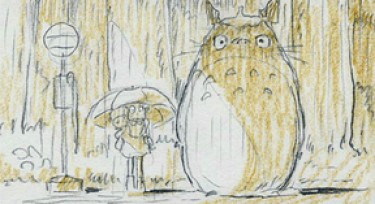 4:30am My Neighbor Totoro (1993)
4:30am My Neighbor Totoro (1993)
Two girls with a sick mother find escape with the spirits of the forest.
Cast: Voices of Dakota Fanning, Timothy Daly, Lea Salonga. Dir: Hayao Miyazaki.
May 19 - 2:00am Whisper of the Heart (1995)
A young girl goes looking for the boy who has checked out all the same library books as she.
Cast: Voices of Brittany Snow, Cary Elwes, Harold Gould. Dir: Yoshifumi Kondo.
4:00am Pom Poko (1994)
A group of magic raccoons use their shape shifting powers to save their forest home.
Cast: Voices of Jonathan Taylor Thomas, Clancy Brown, J.K. Simmons. Dir: Isao Takahata
Animation &Commentary 04 Apr 2006 06:58 am
Double Lives
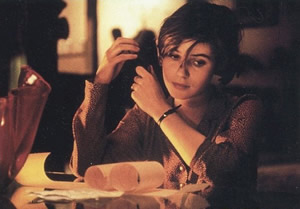 – I thought about Michael Barrier’s argument supporting the notion that it would be best for one person to be the sole animator of a character throughout a film. On his excellent site, this argument has played out for at least several months. It’s a good one.
– I thought about Michael Barrier’s argument supporting the notion that it would be best for one person to be the sole animator of a character throughout a film. On his excellent site, this argument has played out for at least several months. It’s a good one.
I thought about this when I read this week’s New Yorker Magazine review by Anthony Lane of the re-release of Kieslowski‘s The Double Life of Veronique. In that brilliant film, one actress plays two roles – they may be one character, East and West divided/together – but they’re played as if they were two. The characters are separated and move physically closer together throughout the film and even come close to passing each other.
In some ways this isn’t too far from the hackneyed TV cliché – the one actor plays both himself and his evil twin brother. However, in the Kieslowski film, it’s done very well and is germane to the film. Kieslowski isn’t the only one to do this. There were the evil/good twins played by Margot Kidder in Brian de Palma’s Sisters; there was Kim Novak’s dual/singular role in Hichcock’s Vertigo, and, of course, there were Hayley Mills and Lindsay Lohan in two separate versions of The Parent Trap.
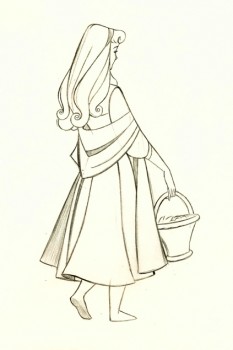 What made me think about Barrier’s argument, was my reading some of the scene breakdowns for Disney’s Sleeping Beauty. We all know that Marc Davis animated the evil queen, Maleficent. I was reminded, reading the breakdowns, that he also animated some of the virginal Aurora in the wooded scenes along with Hal Ambro.
What made me think about Barrier’s argument, was my reading some of the scene breakdowns for Disney’s Sleeping Beauty. We all know that Marc Davis animated the evil queen, Maleficent. I was reminded, reading the breakdowns, that he also animated some of the virginal Aurora in the wooded scenes along with Hal Ambro.
Given the Barrier premise, that one animator should animate or supervise the same character, we have to ask what about the animator who animates two or more characters in the same film. (In the world in which I’ve been animating, this is the more likely.)
Bill Tytla and Fred Moore supervised most of the seven dwarfs. Here we have an animator animating seven principal and titular characters. How does this play into the theory? Is it obvious in that the animator would just follow through on all of her(his) characters and try to give different personalities to them?
(Click image to enlarge.)
Does asking this question preclude that the animator can create seven personalities in the same film? (Moore and Tytla did pretty well by their characters, although it was probably easier to vary the animation of characters named Sleepy and Happy than it would be to give personalities to two named Bill and Mark. There’s always the Lindsay Lohan/Hayley Mills route – give one a British accent the other an American.)
I ask it only because I’m curious to know how one would gauge this side of the same argument. And I wonder if any out there have thoughts on this? Or experiences?
